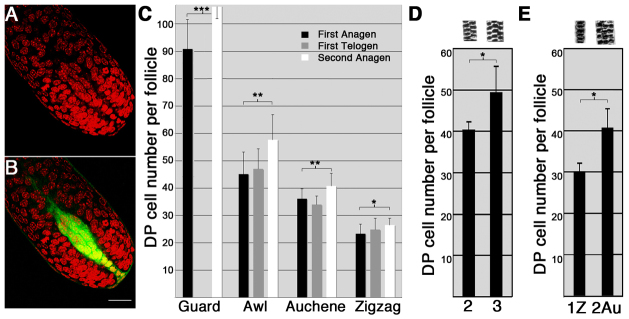Fig. 2.

Follicles producing different hair types have different numbers of DP cells. (A,B) Optical sections showing hair bulb from a Sox2GFP/+ mouse (nuclei indicated in red) (A) and overlay of the same section with DP cells that express GFP (green) (B). Scale bar: 25 μm. (C) DP cell numbers were counted in optical sections of isolated intact hair follicles producing each hair type during first (morphogenetic) anagen (P11, black bars), first telogen (P20, grey bars) and second anagen (P30, white bars). Mean and s.d. are shown. Differences between hair types are significant (P<0.001) at all time points. Differences within hair type between the first and second cycle are significant (*P<0.01; **P<0.001; ***P<0.03). All follicles producing auchene hairs in the second hair cycle produced zigzag hairs in the first cycle. Guard hairs were not analysed during telogen. (Minimum n=20 hairs from two mice per type/time point, except guards, n=6/time point.) (D) Examples of two and three medulla cell thick awls are shown above. There is a significant difference (*P=0.002) between the number of DP cells in follicles that produce thin (2) versus thick (3) awl hairs in the same hair cycle (mean and s.d., n=5 and n=9, respectively). (E) The average DP cell number and s.d. for the 20% of zigzag follicles with the most DP during the first hair cycle (1Z, n=7), and that for follicles producing an auchene in the second hair cycle (2Au, n=20) are shown. All follicles that produced an auchene in the second cycle produced a zigzag hair in the first cycle. The significant difference (*P=1.5×10-8) between these two populations demonstrates that DP cell number has increased as these follicles shift from making zigzag to making auchene hairs.
